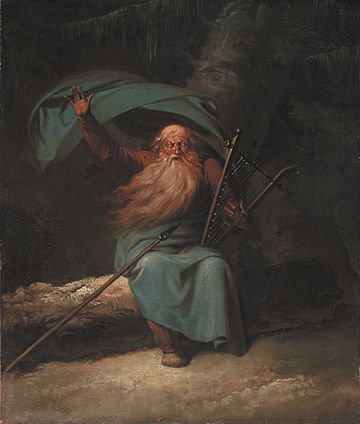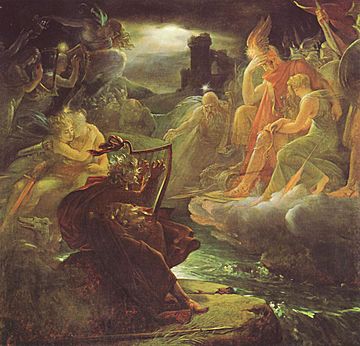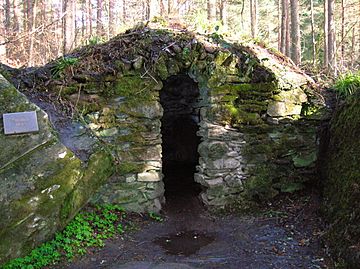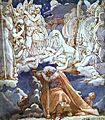Ossian facts for kids

Ossian (in Irish Gaelic and Scottish Gaelic: Oisean) is the storyteller and supposed writer of a series of long poems. These poems were published by a Scottish poet named James Macpherson. They first came out as Fingal (1761) and Temora (1763). Later, they were put together under the title The Poems of Ossian.
Macpherson said he had collected these stories by word-of-mouth in Scottish Gaelic. He claimed they came from very old sources, and that his books were just his translations. Ossian is based on a legendary bard (poet and storyteller) named Oisín. Oisín was the son of Fionn mac Cumhaill (also known as Finn McCool) in Irish mythology.
At the time, people argued if Macpherson's poems were real or made up. Today, most experts agree that Macpherson wrote most of the poems himself. However, he did use some traditional Gaelic poetry he had found.
The poems became very popular around the world. They were translated into many European languages. They also had a big impact on the Romantic movement and the Gaelic revival. Macpherson was even buried in Westminster Abbey, a place for famous writers. W.P. Ker, a historian, said that Macpherson's writing skills were key to his success, even if he wasn't fully honest about the poems' origins.
Contents
The Ossian Poems
In 1760, Macpherson published a book in English called Fragments of ancient poetry. He said he had collected these poems in the Scottish Highlands and translated them from Gaelic. Later that year, he claimed to have found more old writings. In 1761, he announced he had discovered a long poem about a hero named Fingal, supposedly written by Ossian. The name Fingal means "white stranger."
Macpherson said his publisher told him that these old works would only sell in English. So, he translated them. He published these translations over the next few years. In 1765, he put them all together in a collection called The Works of Ossian. The most famous poem from this collection was Fingal, published in 1762.
What the Poems are Like
The poems are written in a style that sounds like poetry but reads like prose. They use short, simple sentences. The mood is grand and epic, like a big adventure story. However, there isn't one single long story. Instead, the same characters appear in different tales.
The main characters include Ossian himself, who tells the stories when he is old and blind. There's also his father, Fingal, who is loosely based on the Irish hero Fionn mac Cumhaill. Ossian's dead son, Oscar, also has an Irish counterpart. Oscar's lover, Malvina, looks after Ossian in his old age. Macpherson invented Malvina's name, like he did with Fiona.
The stories are full of "endless battles and unhappy loves." But the reasons for the fights and who the enemies are often aren't explained well. Characters sometimes accidentally kill people they love. They also die from extreme sadness or even extreme joy. The poems don't give much information about the characters' religion, culture, or daily life. Buildings are rarely mentioned.
The landscape in the poems is very important. It's described as "more real than the people who inhabit it." It's a world of grayness, often covered in mist, with a weak sun or quick flashes of light. Fingal is king of a part of southwest Scotland, possibly like the old kingdom of Dál Riata. The poems seem to be set around the 3rd century. The "king of the world" mentioned in the poems might be the Roman Emperor. Macpherson and his supporters thought they saw mentions of Roman emperors like Caracalla (who died in 217 AD) and Carausius (who died in 293 AD).
The Big Debate: Were They Real?

As soon as Macpherson published his poems, people started arguing about whether they were real. These arguments were about both literature and politics. Macpherson said the stories came from Scotland. But Irish historians strongly disagreed, feeling that their own history was being stolen.
However, both Scotland and Ireland shared a common Gaelic culture during the time the poems were set. Some Fenian stories, which were popular in both countries, were actually written in Scotland.
Famous Critics Weigh In
Samuel Johnson, a famous English writer, was sure that Macpherson was "a trickster, a liar, and a fraud." He believed the poems were completely made up. Johnson also thought the poems were not very good. When someone asked him if anyone today could write such poetry, he famously replied, "Yes. Many men. Many women. And many children."
Johnson called the Ossian story "as big a trick as the world ever saw." He also said that Gaelic was the "rude speech of a barbarous people" and that there were no Gaelic writings older than 100 years. But people soon proved him wrong. The Advocates' library in Edinburgh had Gaelic writings that were 500 years old, and some even older.
Defending Ossian
Hugh Blair, a Scottish writer, wrote a book in 1763 defending the poems' authenticity. His book was included in every edition of Ossian from 1765 onwards to make the work seem more believable. The poems also fit well with the new Romantic movement and the idea of the "noble savage." They were also popular because of Burke's famous book about beauty and the sublime.
In 1766, Charles O'Conor, an Irish expert on old things, said Ossian was not real. He added a new chapter to his history book explaining why. In 1775, he wrote a whole new book criticizing the poems even more.
Because of all the arguments, the Highland Society of London started an investigation. They wanted to know if Macpherson's original writings were real. This led to the discovery of the Glenmasan manuscript. This old text contains a story that is somewhat similar to Macpherson's "Darthula," but it's also very different.
The debate continued into the early 1800s. People argued if the poems came from Irish sources, English sources, or if Macpherson just used small Gaelic pieces and added a lot of his own writing. Some, like Peter Hately Waddell, argued that the poems had real details about places that Macpherson couldn't have known otherwise.
In 1952, a Scottish expert named Derick Thomson studied Macpherson's work. He concluded that Macpherson had collected real Scottish Gaelic ballads. He used people to write down stories that were told orally and gathered old writings. But he changed them, altering characters and ideas, and added much of his own writing.
One strong piece of evidence that Macpherson's 'Ossian' wasn't totally made up comes from the oldest Scottish Gaelic manuscript. This is the Book of the Dean of Lismore (from 1512). In this book, which has heroic poems from as early as 1310, we find the names and adventures of almost all the main characters in Macpherson's poems. This includes Cairbe, Caoilte, Conán, Cormac mac Airt, Cú Chulainn, Diarmad, Eimhear, Fionn mac Cumhaill, Goll mac Morna, Osgar mac Oiséin, and Tréanmhor. It also has legends and traditions linked to these characters.
Ossian and Gaelic Books
Macpherson’s Ossian greatly impressed Dugald Buchanan (1716–68). He was a poet from Perthshire whose famous Spiritual Hymns were written in high-quality Scots Gaelic. Buchanan believed the Ossian poems were real. This made him appreciate the true traditions and rich culture of the Gaels even more.
Around the same time, Buchanan wrote to Sir James Clerk, 3rd Baronet. Clerk was a leading expert on old things. Buchanan suggested that someone should travel to the Scottish Isles and Western Coast. There, they could collect the works of ancient and modern bards. He believed this was the only way to find the purest form of the language.
Much later, in the 19th and 20th centuries, people like Alexander Carmichael and Lady Evelyn Stewart Murray took up this task. Their work was continued by the School of Scottish Studies and the Scottish Gaelic Texts Society. So, it can be said that Dugald Buchanan's reading of Macpherson’s Ossian eventually led to more books being printed in Gaelic. These were not just religious books. This also helped a strong body of Gaelic literature to grow in the 20th and 21st centuries.
Ossian in Art
Stories from the Ossian poems were very popular in art, especially in northern Europe. However, they were popular at different times in different countries. By the time French artists started painting Ossian, British artists had mostly stopped. Ossian was especially liked in Danish art, but also in Germany and other Scandinavian countries.
British artists began painting scenes from Ossian early on. The first big project was a series of paintings on the ceiling of the "Grand Hall" at Penicuik House in Midlothian. Sir James Clerk ordered these paintings in 1772. They were done by the Scottish painter Alexander Runciman. Sadly, these paintings were lost when the house burned down in 1899. However, drawings and etchings of them still exist.
A painting about Ossian by Angelica Kauffman was shown in the Royal Academy of Arts in 1773. The Irish painter James Barry also included Ossian in his large work Elysium. This work decorates the Royal Society of Arts in London and can still be seen today.
Drawings by Thomas Girtin and John Sell Cotman have survived. However, the Ossianic landscapes by George Augustus Wallis seem to be lost. A painting by J. M. W. Turner shown in 1802 is also gone. Henry Singleton exhibited paintings, some of which were turned into engravings for editions of the poems.
The Danish painter Nicolai Abildgaard painted several scenes from Ossian. His students, including Asmus Jacob Carstens, also painted Ossian subjects. His friend Joseph Anton Koch painted many Ossian scenes and two large series of illustrations for the poems. Many of these works were painted in Rome, which might not have been the best place to capture the misty northern light of the poems.
In Germany, Philipp Otto Runge was so excited when asked to make drawings for the poems in 1804 that he planned 100 of them. These drawings were heavily influenced by the simple, line-based illustrations of John Flaxman. Many other German works about Ossian are known, some as late as the 1840s. News of British doubts about the poems was slow to reach Europe, or people simply didn't care.
Art in France
In France, most artistic paintings of Ossian were due to Napoleon's great interest in the poems. A painting shown in the Paris Salon in 1800 by Paul Duqueylar excited a group of artists called Les Barbus ("the Bearded Ones"). This group, including Pierre-Maurice Quays, liked living like "early civilizations" described in Homer, Ossian, and the Bible.
In the same year, Napoleon was planning to fix up the Château de Malmaison as a summer palace. Two large and important paintings for the reception hall were among those commissioned. These were Girodet's Ossian receiving the Ghosts of the French Heroes (1801–02) and François Pascal Simon Gérard's Ossian Evoking ghosts on the Edge of the Lora (1801).
Gérard's original painting was lost in a shipwreck. However, three copies made by the artist still exist. One is now at Malmaison, and another is at the Kunsthalle Hamburg. A watercolour copy by Jean-Baptiste Isabey was placed in Napoleon's own copy of the poems.
Girodet and Gérard were both students of David. The non-classical subjects of the Ossian poems were useful for the new French Romantic painting. They showed a move away from David's Neoclassical choice of historical subjects. David's reactions to these paintings were cautious or negative. He said of Girodet's work: "Either Girodet is mad or I no longer know anything of the art of painting."
Girodet's painting (still at Malmaison) caused a sensation when it was shown in 1802. It is still a key work in the rise of French Romantic painting. Girodet also painted Malvina dying in the arms of Fingal (around 1802) and other works.
Another student of David, Jean-Auguste-Dominique Ingres, painted Ossian scenes throughout his long career. In 1810 or 1811, he was asked to make two paintings for the bedroom Napoleon was to use in the Palazzo Quirinale in Rome. One was The Dream of Ossian. Napoleon never visited, and Ingres later bought the painting back.
Editions and Collections
- 1887: Poems of Ossian: Literally translated from the Gaelic, in the original measure of verse, by Peter McNaughton (Edinburgh: William Blackwood and Sons)
- 1996: The Poems of Ossian and Related Works, edited by Howard Gaskill, with an Introduction by Fiona Stafford (Edinburgh: Edinburgh Univ. Press).
- 2004: Ossian and Ossianism, by Dafydd Moore, (London: Routledge). This is a 4-volume set of Ossianic works and many different responses to them. It includes copies of the Ossian works, letters, reviews, and later adaptations.
- 2011: Blind Ossian's Fingal : fragments and controversy, a reprint of the first edition with new material by Allan and Linda Burnett (Edinburgh: Luath Press Ltd)
The National Library of Scotland has 327 books and related items in its Ossian Collection. This collection was first put together by J. Norman Methven of Perth. It includes different editions and translations of James Macpherson's epic poem 'Ossian'. Some even have a map of the 'Kingdom of Connor'. The collection also has other materials about Ossianic poetry and the debate over its authenticity. More than 200 items from the collection have been made available online.
Images for kids
-
The Songs of Ossian, ink and watercolours, Ingres, 1811–13
-
Fingal Sees the Ghosts of His Ancestors in the Moonlight, Nicolai Abildgaard, 1778





